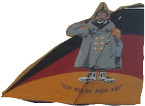mahuja
Posts: 107
Joined: 3/9/2016
Status: offline

|
The overarching theme of this thread assumes that the goal is to have zero losses. Not letting the enemy subs take out any targets. That's simply not viable in this scenario, except by cheats or plain luck.
Count how many clusters of neutral ships there are. Then count how many asw assets you have available. Even if you could have 100% uptime from them, they would not be enough.
The win condition in any ASW scenario should be to prevent the enemy subs from accomplishing their objective.
Then it's just a matter of defining what that objective is. This is why missiles on subs is such a big deal - their location requirements are quite relaxed.
In the backstory of the mission being discussed, the enemy objective is to pressure the US negotiators by threatening civilian traffic. If they lose their subs after doing so, that pressure is relieved afterwards. The dead are already dead. And their killing would be something the US negotiators could pressure them with (war crimes by those who gave the orders?).
In other words, think in terms of why you would not want to be the sub captain doing this for real.
Fear is not a factor in enemy behavior in command.
Command is thus a lot about how to follow through with the threats that keep soldiers/sailors/aviators from doing something in real war.
That train of thought leads to the following plan:
- Throughout this, you may get lucky. Don't waste luck - but don't drop everything else on what may be a false contact.
- The enemies are armed with anti-ship missiles. Keep your AEW up.
- Place a couple passive buoys near (preferrably in front of) each objective (ship you want to protect).
With their wide spread, MPAs will be well suited for doing this to most objectives.
These are not likely to pick up subs. What you aim to detect is not the sub, but torpedoes.
- When you detect a weapon launch, mark the datum. With time. Send your ASW assets.
- When they arrive, look at how many hours it took them, and multiply by the kilo's max speed of 20. This is your search radius. Start from the outside, circling inwards with active buoys.
(If it took 30 minutes = 0.5 hours, then the radius is 10nm)
- Make sure that the sub dies for what it did. Show why this is a bad idea in real life. Because they'd die afterwards.
A few notes:
- At some point towards the end of the scenario, remaining enemy subs may start snorkeling. Having some light coverage of passive buoys around the area may be useful.
- If you don't need a buoy monitor up high, consider loitering low to possibly get a MAD detection. But do loiter - you want the uptime.
- You can find yourself a 'high-value target' or two and try to actively protect them. A Cruise liner, perhaps?
- The surface ships can be standoff helo platforms, deep helo platforms, or combatants. The carrier is basically a standoff helo platform by default.
The deep helo platform wants to be in there, but wants to be undetected.
The combatant wants action. It could be a close escort for some objective.
The FFG has neither asrocs or air defense against their missiles, so it's not qualified for the combatant role. What it does have, is space for two helicopters.
- Consider having at least one helicopter at each ship on an asw strike mission - on standby on the pad until a goblin shows up.
----
Since the topic is 'diesel subs' in general I thought I'd add another trick to the discussion.
In a scenario where
- enemy torpedo subs are trying to hit your ships
- the enemy can track your ships' locations
then you want to use high speed. The geometry shows that they need to have a proportional increase in speed to do the intercepts.
Then, change your course every now and then. Depending on the situation, in particular their torpedo range, but a minimum of 20 minutes between each turn (for this purpose).
This will waste some of the intercept effort they've already put in, whether it was too much or too little. The greater the change of direction, the greater the effect.
Against a human, you also have to keep from being predictable.
This basically reduces them to manned, wide area mines.
If you're traveling at their max speed, they have to be in the front 90 degree cone along your path of travel to be able to do an intercept. If you go faster, that area tightens.
Once they're outside of that cone, they will not be able to accomplish their mission, which should be your win.
The drawback is that you're louder (they were tracking you anyway?), deafer (the difference between 0.5nm and 0nm detection range?), and even more dependent on your airborne ASW assets. And when that matters, it takes more fuel too.
|
 Printable Version
Printable Version












 New Messages
New Messages No New Messages
No New Messages Hot Topic w/ New Messages
Hot Topic w/ New Messages Hot Topic w/o New Messages
Hot Topic w/o New Messages Locked w/ New Messages
Locked w/ New Messages Locked w/o New Messages
Locked w/o New Messages Post New Thread
Post New Thread